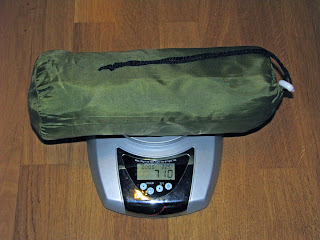eBay gave me very few options in my price range (not willing to spend a hundred euros on something I don't know I like or am able to sleep in). One of the options was the Tenth Wonder company from Worcestershire, UK. I've never had their products before, so this was a new acquaintance. I ordered a black "Compact Camping/Bushcraft Hammock", and a tarp to go with it. A separate review for the tarp is coming soon after this one.
The combined price and shipping costs for the hammock were very reasonable, €17.38 (~25USD). Delivery was fast, about five work days to my mailbox. This is fast, as the Finnish post is usually quite slow with this stuff.
The hammock came packed in a green bag made of parachute fabric. The weight of the bag was 710 grams, which was a disappointment, as the hammock was promised to weight 500 grams. The reason for the weight difference was obvious - the manufacturer does not count the ropes to the weight, only fabric. This is misleading in my opinion, as the hammock is useless without those very ropes. They are an essential part of it, and should be counted in the weight. The fabric itself weights exactly 500 grams when weighted separately.
 |
| The weight of the entire package. |
The contains of the bag are two flat green ropes about three meters each and the hammock fabric, measuring about 240cm long and 145cm wide when folded once upon itself. There are rope canals woven in each end for the rope, and the ropes are already threaded through them. The canals are reinforced with a thicker fabric, which seems rational. The seams are good quality, and there are no loose thread ends or pieces of thread hanging around. The fabric is rectangular, there are no modifications to the shape.
The fabric is folded on top of itself, making a pocket in between. This would be a good spot for your foam pad, if you do not use a quilt for insulation on the underside. I also tested if the fabric would hold my weight if i went between the layers, and indeed it did. I was able to fully enclose myself between the layers, laying in a complete cocoon.
 |
| The hammock and the ropes straight from the package. |
The hammock has a small label containing usage and cleaning instructions. Some of the instructions are good and sound, others are not. The label has a semi-humorous political message on it, which is something I'd prefer the manufacturer left out, although the message itself is sound (damn them lizards). I don't want to buy a product with any kind of political message without knowing about it, humourous or otherwise.
 |
| A hidden agenda? |
I hung the hammock on my porch for some time and spent some time in it on the hot summer days, trying to get the feel to it. It hangs nicely, the ropes are good and do not stretch. My first actual night spent in the hammock was a few weeks ago, in typical Finnish mixed-tree forest environment. The flat ropes seem to be gentle on the trees, and although I did not have any treehuggers or straps, I did not see any damage on the two pines where I tied the hammock. The hammock is quite short, but that is the price of the light weight. I still am able to lie in it without much discomfort, although it does crimp on my shoulders a bit. Laying diagonally does not really work because of the short length, as it would result in either my head or my feet hanging outside the hammock.
 |
| Hanging around. |
I had a modified down sleeping bag as a peapod-type quilt for the first night, and it worked excellent. With a tarp as rain protection, I only woke up once during the night and even that was not because of the the hammock, but for my own stupidity. Why do I always have to drink a lot before going to sleep? :) The night was comfortable, warm and cozy.
 |
| The peapod sleeping bag. |
 |
| With the tarp on top. |
The first actual test was a great success, and I intend to modify and use this hammock extensively for as long as the weathers allow. I intend to even try out winter-hammocking.
Conclusion:
A good hammock for it's price. I have a limited experience with hammocks but I liked it, I liked the low weight and the simplicity. This hammock will see a lot of usage.
Pros:
-Price
-Weight
-Simplicity
-Quality
-Good ropes
Cons:
-Political messages









































